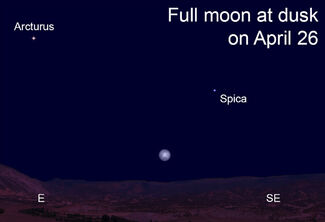Why Doesn't the Moon Rotate?
Last updated 5/4/2021 at 12:21pm

To keep the same features aimed toward the Earth, the moon must rotate on its axis at the same rate as it orbits our planet.
Here we are, already at the end of April, and with this season comes some beautiful evening weather to help us enjoy our night sky viewing. This week, the full moon illuminates our sky on Monday, April 26, and as the full moon always does, it will rise above the eastern horizon around the time the sun sets below the western horizon.
You may sometimes hear the April full moon referred to as the "pink moon," "sprouting grass moon" or even the "egg moon." My favorite of these Native American names, however, is the "fish moon," since it's at this time that the shad swim the Delaware River separating Pennsylvania from New Jersey where I grew up, creating an exciting time for anglers.
All are wonderful stories, but there's one concept about the moon that seems to puzzle just about everyone. All sky watchers who have ever viewed the moon's monthly cycle through the heavens have surely noticed that we only ever see one side of the moon.
This simple observation naturally begs the question, "Does the moon rotate, or doesn't it?"
It might not surprise you that everyone seems to have their own answer – yes or no – and each person is positive they are correct. So, let's try a practical demonstration to help clear up the matter.
In this experiment, you will represent the Earth, sitting or standing in the center of a room. Get a friend to represent the moon a few feet away. This person will need to walk completely around you in a lunar "orbit." The walls, ceiling and floor of the room will represent the distant stars.
Let's first make the moon orbit the Earth without rotating. In other words, have your friend choose a point on a distant wall and face it constantly as he or she walks around you. From your position at the center, what do you see of your friend during their entire orbit?

OK, now try the same thing with your friend twirling around as he or she orbits you. Now, what can you see of the moon from the central "Earth"?
In both cases of this experiment, you will see all sides of the moon, yet in the real sky, we see only one side. So, what's going on here?
The secret is that, to keep the same features aimed toward the Earth, the moon must rotate on its axis at the same rate as it orbits our planet. This is not a coincidence; over billions of years, the Earth's strong gravitation has locked the much smaller moon into this configuration.
To demonstrate "tidal locking," have your friend walk one-quarter of the way around the orbit; to aim their face constantly in your direction, he or she must "rotate" one-quarter of the way around. Another quarter of an orbit, another quarter of a rotation. And so on.
It appears that the question of the moon's rotation has two equally correct answers, depending upon your viewpoint. From the central Earth, the answer would be, "No, the moon does not rotate," but I'll bet your "lunar friend," having spun themselves into dizziness, will surely disagree!
Visit Dennis Mammana at dennismammana.com.


